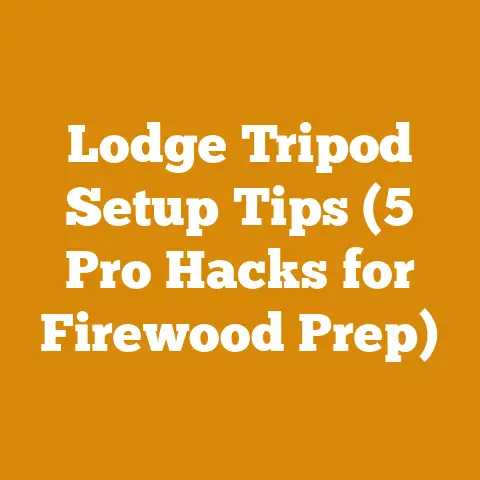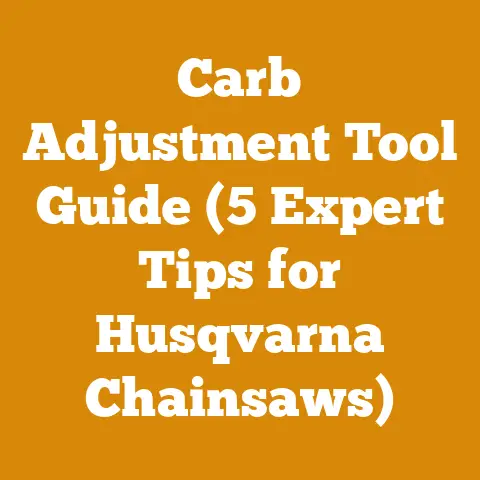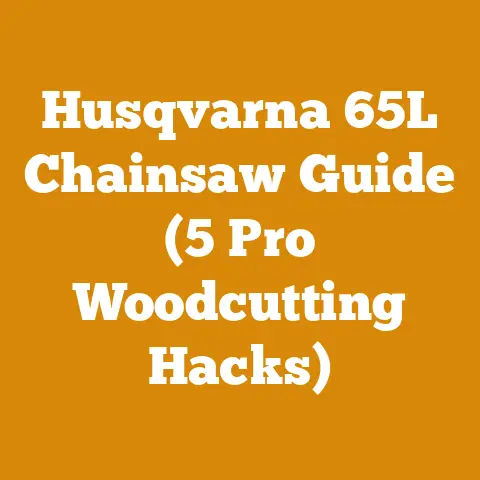Box Sides Upgrade for Trucks (5 Pro Firewood Hauling Hacks)
As the leaves turn crimson and gold, and the air carries a crisp, cool bite, there’s a primal call that resonates within many of us. It’s the call of the hearth, the crackle of a comforting fire, and the satisfying work of preparing for winter. And for many, that preparation involves hauling firewood. But how many times have you looked at your truck bed, piled high with logs, and thought, “There has to be a better way?”
You’re not alone. According to a recent report by the Hearth, Patio & Barbecue Association (HPBA), over 70% of U.S. households with fireplaces use firewood as their primary or secondary heat source. Globally, the demand for firewood remains significant, especially in colder climates and rural areas. This translates to a lot of firewood being hauled, and inefficient hauling means more trips, wasted time, and potential damage to your truck.
That’s where box side upgrades come in. I’ve spent years splitting wood, felling trees, and hauling countless loads of firewood in my trusty old pickup. I’ve learned a thing or two about maximizing hauling capacity and protecting my truck bed. Trust me, investing in your truck’s hauling capabilities is an investment in your time, your back, and the longevity of your vehicle. So, let’s dive into five pro hacks for upgrading your truck box sides to become a firewood-hauling champion!
Box Sides Upgrade for Trucks: 5 Pro Firewood Hauling Hacks
1. Understanding the Need: Why Upgrade Your Truck Box Sides?
Before we get into the nitty-gritty of upgrades, let’s understand why it’s even necessary. Standard truck beds are often designed for general-purpose hauling, not specifically for the weight and volume of firewood. Here’s a breakdown:
- Increased Capacity: Stock truck beds have limited height. Adding box sides significantly increases the volume of firewood you can carry in a single trip. Think of it like this: you’re not just adding height; you’re multiplying the hauling potential.
- Load Security: Firewood is notorious for shifting during transport. Higher box sides help contain the load, preventing logs from spilling out, especially on rough terrain. It’s about keeping your load on the truck, not off it.
- Truck Bed Protection: Firewood can be rough on your truck bed. The weight, sharp edges, and constant loading/unloading can cause dents, scratches, and even structural damage. Upgraded box sides can act as a barrier, protecting your investment.
- Safety: A secure load is a safe load. Preventing firewood from falling onto the road reduces the risk of accidents and keeps you, and other drivers, safe. We’re talking about preventing a serious hazard here.
I remember one particularly harrowing experience hauling green oak. I thought I had secured the load adequately, but halfway down a bumpy logging road, a large log bounced out, narrowly missing a passing car. That was a wake-up call, and it prompted me to seriously consider upgrading my truck’s box sides.
2. Hack #1: DIY Wood Box Sides – The Budget-Friendly Option
For the budget-conscious firewood hauler, DIY wood box sides are an excellent option. This method allows for customization and uses readily available materials. Here’s a step-by-step guide:
Materials You’ll Need:
- Lumber: I recommend using pressure-treated lumber for durability and weather resistance. 2×6 or 2×8 boards are ideal for the sides, and 4×4 posts for the corners. Consider the length of your truck bed when determining the amount of lumber you’ll need.
- Hardware: Galvanized screws (at least 3 inches long), bolts, washers, and lock nuts. Galvanized hardware is crucial to prevent rust and corrosion.
- Tools: Circular saw, drill, measuring tape, pencil, clamps, safety glasses, and work gloves.
- Optional: Wood sealant or paint for added protection.
Step-by-Step Instructions:
- Measure and Cut: Measure the inside length and width of your truck bed. Cut the lumber according to these dimensions. You’ll need to cut the side boards, end boards, and corner posts. Precision is key here. A slightly off measurement can lead to a wobbly structure.
- Assemble the Frame: Attach the side and end boards to the corner posts using screws and bolts. Ensure the frame is square and sturdy. Clamps are your best friend during this stage. They help hold everything in place while you’re screwing or bolting.
- Secure to Truck Bed: There are several ways to secure the wood box sides to your truck bed. You can use J-bolts that hook under the bed rails, or you can drill through the bed and bolt the frame directly. Choose the method that works best for your truck and your comfort level.
- Reinforce (Optional): For added strength, consider adding cross braces between the corner posts. This will prevent the sides from bowing outwards when loaded with heavy firewood.
- Seal or Paint (Optional): Apply a wood sealant or paint to protect the wood from the elements. This will extend the life of your DIY box sides.
Data Point: A study by the Forest Products Laboratory found that pressure-treated lumber can last up to 40 years when properly maintained, making it a worthwhile investment for your DIY box sides.
Cost Considerations:
The cost of DIY wood box sides can range from $150 to $400, depending on the type of lumber and hardware you choose. This is significantly cheaper than commercially available options.
Troubleshooting:
- Wobbly Frame: Ensure all connections are tight and square. Add additional bracing if necessary.
- Rusting Hardware: Use only galvanized hardware. Apply a rust inhibitor to any exposed metal.
- Wood Rot: Regularly inspect the wood for signs of rot. Apply a fresh coat of sealant or paint as needed.
I built my first set of wood box sides using reclaimed lumber from an old barn. It wasn’t the prettiest setup, but it was incredibly functional and saved me a ton of money. It taught me the value of resourcefulness and the satisfaction of building something with my own hands.
3. Hack #2: Metal Mesh Box Sides – Lightweight and Durable
Metal mesh box sides offer a good balance of strength, weight, and visibility. They’re more durable than wood and lighter than solid steel, making them a popular choice for many firewood haulers.
Materials You’ll Need:
- Metal Mesh: Choose a heavy-duty metal mesh with a small enough opening to prevent firewood from falling through. Welded wire mesh is a good option.
- Steel Tubing or Angle Iron: For the frame. The size and thickness will depend on the size of your truck bed and the weight of the firewood you’ll be hauling.
- Welding Equipment: Welder, welding helmet, gloves, and safety glasses.
- Cutting Tools: Angle grinder with a cutting wheel.
- Hardware: Bolts, washers, and lock nuts.
- Primer and Paint: To prevent rust and corrosion.
Step-by-Step Instructions:
- Measure and Cut: Measure the inside length and width of your truck bed. Cut the steel tubing or angle iron according to these dimensions. Cut the metal mesh to fit the frame.
- Weld the Frame: Weld the steel tubing or angle iron together to create a rectangular frame. Ensure the frame is square and strong.
- Attach the Metal Mesh: Weld the metal mesh to the inside of the frame. Make sure the mesh is securely attached and that there are no sharp edges.
- Secure to Truck Bed: Use bolts and washers to attach the metal mesh box sides to your truck bed. You can use the same mounting points as with the DIY wood box sides.
- Prime and Paint: Apply a primer and paint to the metal frame and mesh to prevent rust and corrosion.
Data Point: Steel has a tensile strength of around 400 MPa (megapascals), making it significantly stronger than wood. This means metal mesh box sides can withstand heavier loads and more abuse.
Cost Considerations:
Metal mesh box sides can cost between $300 and $600, depending on the type of metal and the amount of welding required.
Troubleshooting:
- Weak Welds: Ensure all welds are strong and properly fused. Practice your welding skills before starting the project.
- Rust: Apply a high-quality primer and paint to prevent rust. Regularly inspect the metal for signs of corrosion.
- Sharp Edges: Grind down any sharp edges to prevent injury.
I once helped a friend build metal mesh box sides for his logging truck. He was constantly hauling heavy loads of timber, and the metal mesh provided the strength and durability he needed. It was a challenging project, but the end result was well worth the effort.
4. Hack #3: Stake Bed Conversion – The Ultimate Hauling Solution
For serious firewood haulers who need maximum capacity and versatility, a stake bed conversion is the ultimate solution. This involves removing the existing truck bed and replacing it with a custom-built stake bed.
Materials You’ll Need:
- Steel or Aluminum Frame: The main structure of the stake bed. Steel is stronger, but aluminum is lighter and more corrosion-resistant.
- Wood or Metal Stakes: To create the sides of the bed. Wood stakes are more traditional, while metal stakes are more durable.
- Decking Material: For the floor of the bed. Pressure-treated lumber or steel grating are good options.
- Hardware: Bolts, washers, and lock nuts.
- Welding Equipment (if using steel): Welder, welding helmet, gloves, and safety glasses.
- Cutting Tools: Angle grinder with a cutting wheel.
- Wiring Harness: To connect the truck’s electrical system to the stake bed’s lights.
Step-by-Step Instructions:
- Remove the Existing Truck Bed: This is the most challenging part of the project. You’ll need to disconnect the wiring harness and unbolt the bed from the frame. It’s best to have a friend help with this step.
- Build the Frame: Weld or bolt together the steel or aluminum frame. Ensure the frame is strong and properly aligned with the truck’s frame.
- Install the Decking: Attach the decking material to the frame using screws or bolts.
- Install the Stakes: Attach the stakes to the frame. You can use wood or metal stakes, depending on your preference.
- Connect the Wiring Harness: Connect the truck’s electrical system to the stake bed’s lights.
- Secure to Truck Frame: Bolt the stake bed frame to the truck’s frame.
Data Point: A stake bed can increase your truck’s hauling capacity by up to 50%, allowing you to transport significantly more firewood in a single trip.
Cost Considerations:
A stake bed conversion can cost between $1,000 and $5,000, depending on the materials and the complexity of the design.
Troubleshooting:
- Misalignment: Ensure the frame is properly aligned with the truck’s frame. Use shims if necessary.
- Electrical Issues: Double-check all wiring connections. Use a multimeter to troubleshoot any electrical problems.
- Structural Weakness: Reinforce the frame with additional bracing if necessary.
I’ve seen several stake bed conversions on logging trucks in my area. They’re incredibly versatile and can be customized to haul just about anything. While it’s a more involved project, the increased hauling capacity and versatility make it well worth the investment for serious firewood haulers.
5. Hack #4: Commercial Box Side Extensions – The Easy Button
If you’re not comfortable with DIY projects or welding, commercial box side extensions are a great option. These are pre-fabricated extensions that bolt onto your existing truck bed, providing increased height and load security.
Types of Commercial Box Side Extensions:
- Mesh Extensions: Similar to the DIY metal mesh box sides, these extensions provide good visibility and airflow.
- Solid Steel Extensions: These extensions offer maximum strength and protection.
- Aluminum Extensions: Lightweight and corrosion-resistant.
Installation:
Commercial box side extensions are typically easy to install. They usually bolt onto the existing truck bed using existing mounting points.
Cost Considerations:
Commercial box side extensions can cost between $500 and $1,500, depending on the type of extension and the brand.
Advantages:
- Easy Installation: No welding or fabrication required.
- Professional Finish: Commercial extensions typically have a high-quality finish and a professional look.
- Warranty: Many commercial extensions come with a warranty.
Disadvantages:
- Less Customization: You’re limited to the sizes and designs that are available.
- Higher Cost: Commercial extensions are typically more expensive than DIY options.
I’ve used commercial box side extensions on several of my trucks over the years. They’re a convenient and reliable way to increase hauling capacity without having to spend a lot of time and effort on DIY projects.
6. Hack #5: Tarping and Strapping – The Essential Security Measure
No matter which type of box side upgrade you choose, tarping and strapping your load is essential for safety and security. A properly secured load prevents firewood from shifting or falling out, reducing the risk of accidents and protecting your truck.
Materials You’ll Need:
- Heavy-Duty Tarp: Choose a tarp that is large enough to cover your entire load.
- Ratchet Straps: Use heavy-duty ratchet straps to secure the tarp to the truck bed.
- Bungee Cords (Optional): For securing loose ends of the tarp.
Step-by-Step Instructions:
- Load the Firewood: Load the firewood evenly into the truck bed.
- Cover with Tarp: Drape the tarp over the load, ensuring it covers the entire load and extends down the sides of the box side upgrades.
- Secure with Ratchet Straps: Attach the ratchet straps to the tarp and the truck bed. Tighten the straps until the tarp is snug and the load is secure.
- Secure Loose Ends (Optional): Use bungee cords to secure any loose ends of the tarp.
Tips for Tarping and Strapping:
- Use High-Quality Tarps and Straps: Cheap tarps and straps can tear or break under stress, compromising the security of your load.
- Distribute the Load Evenly: An unevenly distributed load can shift during transport, making it more difficult to secure.
- Check the Straps Regularly: Check the straps periodically during transport to ensure they are still tight.
I always carry a heavy-duty tarp and a set of ratchet straps in my truck. They’ve saved me countless times from potential disasters. It’s a small investment that can make a big difference in safety and peace of mind.
Bonus Tip: Understanding Wood Density and Weight
Before you even start hauling, it’s crucial to understand the weight of the wood you’re dealing with. Different wood species have vastly different densities, and that directly impacts how much weight you’re putting on your truck.
- Green Wood vs. Seasoned Wood: Green wood (freshly cut) can weigh significantly more than seasoned wood (dried). Water adds a lot of weight.
- Wood Species: Oak, maple, and hickory are dense hardwoods and will weigh more per cord than softer woods like pine, poplar, or cedar.
- Estimating Weight: A full cord of green oak can weigh upwards of 5,000 pounds! A cord of seasoned pine might weigh closer to 2,500 pounds.
Actionable Tip: Use a wood weight calculator online to estimate the weight of your load based on species and moisture content. This will help you avoid overloading your truck and damaging your suspension.
The Bottom Line: Haul Smart, Haul Safe
Upgrading your truck box sides for firewood hauling is an investment that pays off in increased capacity, load security, and truck bed protection. Whether you choose a DIY solution or a commercial product, remember to prioritize safety and always secure your load properly. By following these five pro hacks, you can transform your truck into a firewood-hauling machine and make your winter preparations a whole lot easier.
Now, go forth and conquer that woodpile! And remember, a little preparation goes a long way in ensuring a safe and efficient firewood-hauling season. And when the first snow falls and the fire is roaring, you’ll be glad you took the time to upgrade your truck.
Next Steps and Additional Resources:
- Local Lumber Yards: Source pressure-treated lumber for DIY projects.
- Welding Supply Stores: Find welding equipment and supplies for metal mesh box sides.
- Truck Accessory Retailers: Purchase commercial box side extensions and tarps.
- Online Forums: Connect with other firewood haulers and share tips and advice.
- Equipment Rental Services: Rent equipment like trailers and wood splitters to make the job easier.
Happy hauling!






